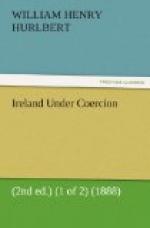Yet it is on all hands admitted that the “unity, solidity, and prosperity” of the British Empire have never been so seriously threatened in Ireland as during the last ten years. Was the Archbishop wrong, therefore, in his estimate of the situation in 1868? Or has the centripetal influence of remedial British legislation since 1868 failed to check a centrifugal advance “by leaps and bounds,” in the “assimilating power” of America upon Ireland?
IV.
Just ten years ago, in 1878, Mr. Michael Davitt and Mr. John Devoy (the latter of whom had been commissioned in 1865 by the Fenian leader Stephens, as “chief organiser of the Irish Republican Brotherhood in the British army"), being then together in America, promulgated, Mr. Davitt in a speech at Boston, and Mr. Devoy in a letter sent to the Freeman’s Journal in Dublin, the outlines of a scheme for overthrowing British rule in Ireland by revolutionising the ownership of land in that country.
The basis of this scheme had been laid thirty years before, in 1848, by Finton Lalor, John Mitchel, and the present Archbishop of Cashel, then a simple curate.
It was thus stated by Lalor in his paper, the Irish Felon:—
“The entire ownership of Ireland, moral and material, up to the sun and down to the centre of the earth, is vested, as of right, in the people of Ireland. The soil of the country belongs as of right to the entire people of the country, not to any one class, but to the nation.”
This was a distinct denial of the right of private property in land. If true of Ireland and the Irish people this proposition was true of all lands and of all peoples. Lalor, though more of a patriot than of a philosopher, saw this plainly; and in one of the three numbers of his paper which appeared before it was suppressed by the British Government, he said “the principle I propose goes to the foundations of Europe, and sooner or later will cause Europe to uprise.” Michael Davitt saw this as clearly in 1878 as Finton Lalor thirty years before. He had matured his plans in connection with this principle during the weary but not wasted years of his imprisonment as a Fenian at Dartmoor, a place, the name of which is connected in America with many odious memories of the second war between England and the United States; and going out to America almost immediately after his release on a ticket of leave, he there found the ideas of Finton Lalor and his associates of 1848, ripened and harvested in the mind of an American student of sociology, Henry George. Nowhere in the world has what a shrewd English traveller calls “the illegitimate development of private wealth” attained such proportions in modern times as in America, and especially in California. Nowhere, too, in the world is the ostentatious waste of the results of labour upon the antics of a frivolous plutocracy a more crying peril of our times than in America. Henry George,




